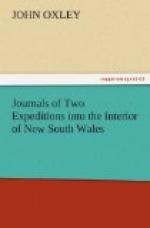[Note: Other genera of chenopodeae likewise exist on these plains, of which some salsolae, and that curious lanigerous shrub sclerolaena paradoxa of Mr. Brown, with spinous fruit, are most remarkable.]
June 25.—The weather cold, but fine: the thermometer is about 28 degrees, and I think from this extraordinary degree of cold so far to the north, that notwithstanding the lowness of the surrounding country (as compared to its relative situation with the river), that we are still at a considerable elevation above the sea. In our last journey, three degrees farther south, we experienced at the same season no such cold, the weather being equally fine and clear as at present. The appearance of the country was much the same as yesterday; the whole ground we passed over being liable to flood, and covered with eucalyptus or gum tree, acacia pendula, and various other species of that extensive genus, one of which appeared quite new but not in flower. Four or five miles back from the river (east), the country rises and is not flooded, the soil being there much inferior, but covered with fine cypresses: notwithstanding this tract was much higher than that more immediately on the river, there was no eminence from which we could look around. The banks of the river are much lower than yesterday, scarcely exceeding twelve feet high; the floods are low in proportion, and I did not see any mark showing that the rise of water ever exceeded a foot above the banks. The river did not offer the slightest obstruction, and was from twenty to twenty-four feet deep. There is probably from two to three feet more in it than usual; the breadth varies considerably, in some places not more than sixty feet, in others two hundred. All the lagoons (though very deep), in the neighbourhood of the river are quite dry, and appearances indicate that the country has not been flooded for years. Emus and kangaroos are in abundance; but we have lately caught no fish, owing most likely to the coldness of the weather: various birds altogether unknown to us were seen; and although the leading plants were the same as those found through nearly the whole of Australia, new ones were daily met with. The river has continued inclining to the northward: its course to-day was north-north-west.




